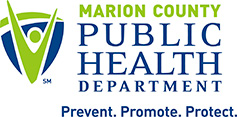The Marion County Public Health Department’s Environmental Public Health Tracking Program was created in August 2022 after the agency was awarded a grant to join the Center for Disease Control’s (CDC) National Environmental Public Health Tracking Program. We invite you to explore our data, learn more about our tracking program, or review further resources at the links below.
Explore Data
What is Environmental Tracking?
For more than 20 years, the CDC’s National Environmental Public Health Tracking Program has collected, integrated, and analyzed non-infectious disease and environmental data from a nationwide group of partners—over 30 states and numerous counties are represented in this network.
MCPHD’s tracking program seeks to provide data on health, the environment, and our population’s demographics to empower the public to review and analyze this data.
What do we track?
Currently, MCPHD’s tracking portal is focused on a core set of hospitalization and emergency department (ED) data, birth defects, community water systems data, and population demographics. Future versions will include radon, food security and safety, climate and weather, and more.
Standard Terms/Definitions
· Environmental Tracking: Environmental tracking or Environmental public health tracking is the ongoing collection, integration, analysis, and dissemination of data from environmental hazard monitoring, human exposure tracking, and health effect surveillance.
· Health Outcomes: data that quantifies the amount of a condition (disease, infection, etc.) in a given group of people. Health outcomes included in this dashboard include asthma, heart attacks, carbon monoxide poisoning events, and more.
· Environmental Health: Environmental health is a part of public health that looks at how people and the environment impact one another. It promotes the health of humans and the environment and works to help build healthy communities.
· Environmental Health Hazards: Environmental health hazards can harm a person’s health. These hazards can be natural, a normal part of the environment or they may be human-made. Examples of environmental hazards include lead paint, radiation, and air pollution.
· Data visualization: Data visualization is showing data (information or numbers) using a picture, graphic, or animation.
· Data stories: Data stories try to tell a story from data. Questions? Contact our program at MCPHDTracking@marionhealth.org
For more information on health outcomes and/or environmental health, check out the links below:
· Other MCPHD Data Tools
o https://aca-prod.accela.com/mcphd/Default.aspx
o https://hhcwebfood.hhcorp.org/default.aspx
o https://marionhealth.org/COVIDDashboard/DR4417-COVID-Public-Information-Dashboard.html
o http://www.indyindicators.iupui.edu/
· Environmental Health
o https://ephtracking.cdc.gov/DataExplorer/
o https://ejscreen.epa.gov/mapper/
o https://www.weather.gov/wrn/
· Demographics, Physical Characteristics (People & Places)
o https://www.cityhealthdashboard.com/in/indianapolis/city-overview
o https://pcrd.purdue.edu/ruralindianastats/
· Newsletter
Questions? Contact our program at MCPHDTracking@marionhealth.org
Questions? Contact our program at MCPHDTracking@marionhealth.org







